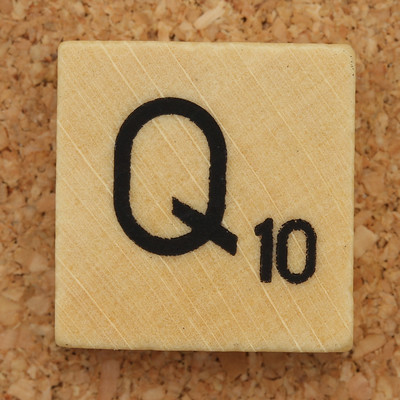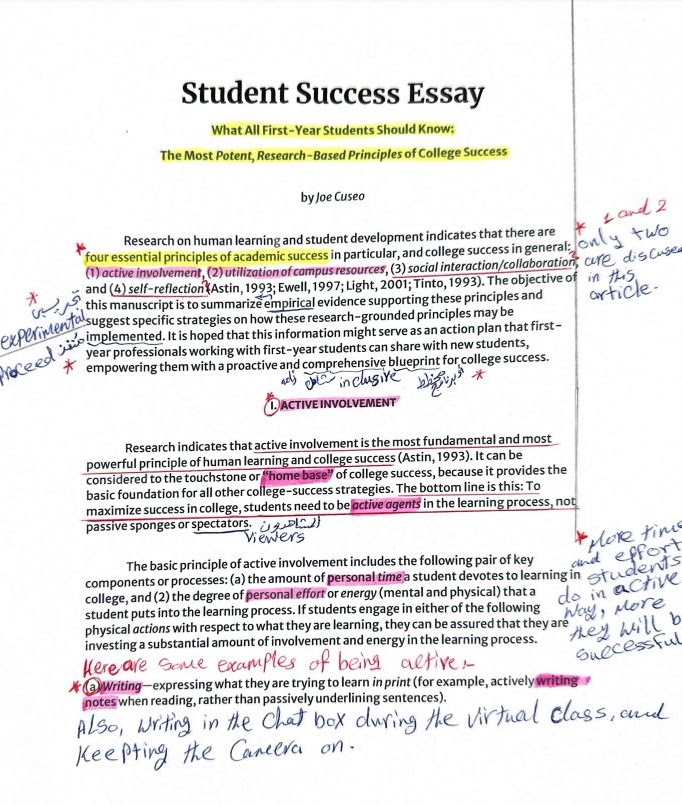Chapter 2: Active Reading Skills and Strategies
What makes someone a “good” reader? Are there ways we can become better readers? Reading is a skill that you can practice and improve. There are several different strategies you can use to become a better reader. Keep reading to understand each strategy.
What does “active reading” mean?
Active reading means purposefully interacting with the text. It involves activities such as highlighting key points, taking notes, asking questions, summarizing, reorganizing information and reflecting. Active reading is especially helpful for academic studies, research, and professional development, as it promotes deeper understanding and greater retention. Active reading is the opposite of passive reading, which is what we sometimes do when we skim over the words without much thought or intention.
SQ3R
SQ3R is a reading strategy you can use when you have an article, essay, or chapter to read for a class, and you really want to comprehend it. It can be used to approach a difficult or long reading. It can also be used when you need to read quickly to gain an understanding of a reading in a hurry!
If you have to read a difficult, long, or boring text, it can be extremely helpful to have a strategy or a plan for how you are going to approach the reading. SQ3R is a great approach to learn and practice the next time you have to complete a reading that is difficult to finish. So what is SQ3R and how do you do it? SQ3R is an acronym, which means each letter or number represents a step in the process. Follow along below to learn what each step of the process entails.
S = Survey or Skim
 When you’re assigned a new reading, you should survey or skim the entire reading before you begin. Look for topics, key words, and any summaries.
When you’re assigned a new reading, you should survey or skim the entire reading before you begin. Look for topics, key words, and any summaries.
Why would it be helpful to skim the reading before you read? Doesn’t that just waste more time?
Actually, knowing what you’re going to read, how long it is, what type of information you’re going to encounter, and what subheadings or subsections you need to understand can be very helpful and allow you to take some shortcuts while still increasing your understanding. Surveying a reading first should take only about 1 minute, and it really does prep your brain for what you want it to learn.
When you survey the reading, it gives your mind a purpose, so you are less likely to be distracted by things like “What’s for dinner?” and “Who is texting me?”

Q = Question
As you’re skimming the text, try to become curious about it by asking yourself some questions about it before you begin reading.
Asking yourself questions about the text before you get started reading will provide you with an additional purpose for reading: to get the answers to those questions. Your brain will be more likely to work for you instead of getting distracted.
Not sure what questions to ask yourself? Sometimes the author will have some at the end of a chapter. Other times, your teacher may provide some. The easiest way to come up with guiding questions is to turn the titles, headings, and bold words you noticed when surveying into questions. If all else fails, ask yourself, “What is the point of this reading?”
In this step, you will read the text. Focus on reading in chunks, or manageable sections.
For very complex or dense material, such as tax forms, research articles, or the FAFSA application, this may mean reading only a few lines at a time.
For more approachable material, such as a textbook, a chunk is morel likely to be a paragraph or two with its own heading.
If you are reading a short story or novel, you will find that you can read longer sections at a time.

As you read each chunk stop periodically to recite; say or write a brief summary of what you just read in your own words. This is also a good time to answer those questions you came up with. Think about reciting as taking a quick pause to make sure you are comprehending along the way.
Have you ever read something, and when you got to the end, you realized that you were not so sure what the reading was all about? Reciting helps prevent this. If you can say or write what something is about in your own words, that is a good sign that you are understanding the author’s points, and it is okay to go on to read the next section.
After you’ve read the entire work or a large section, you should review what you’ve read. This step involves looking back over the smaller sections to make sure you understand how it all fits together.
If your purpose is to put information into long-term memory, maybe to prepare for a test or because you need to know it for your career, you need to do spaced review. This means putting longer and longer time periods in between review or study sessions.
Annotation
 Annotation is the practice of adding notes directly to a text. While it is a method of notetaking, it is also a reading strategy because it can improve our comprehension, particularly on complex readings.
Annotation is the practice of adding notes directly to a text. While it is a method of notetaking, it is also a reading strategy because it can improve our comprehension, particularly on complex readings.
When we need a deep understanding of a reading, perhaps to write an essay or pass a test, and we have plenty of time to read, annotation is an effective approach.
Why Annotate?
-
To Read More Actively
Annotating forces us to stay focused and engaged in the reading and to process the material instead of reading passively.
-
To Enhance Understanding.
Annotating helps break down complex ideas and thus builds comprehension.
-
To Facilitate Critical Thinking
Annotating encourages us to ask questions, draw connections, and analyze the author’s points.
Writing notes in our own words and marking key points make the material more memorable. This helps for reviewing and preparing for exams.
Steps for Effective Annotating
-
Preview the Text.
Skim headings, subheadings, summaries, and introductions to get an overview of what it is going to be about. It’s important to become familiar with the reading BEFORE you start marking it.
-
Use Tools.
Use highlighters, pens, or digital annotation tools. Assign different colors for specific purposes (e.g., key ideas, unfamiliar terms, important examples). We want our notes to stand out so that we can find them later, and so they can help us review.
-
Highlight Key Information.
Mark main ideas, thesis statements, and essential arguments. Avoid over-highlighting; focus on critical points.
-
Write Notes in the Margins.
Summarize ideas in your own words. Pose questions or note areas of confusion. Record connections to other readings or personal experiences.
-
Use a System of Symbols That Works for You.
Symbols allow you to see important ideas at a glance without rereading or searching. Underline or circle key terms important to understanding the text. Use symbols as a shorthand. For example, confusing points may be marked with ❓; key points with ✳; and surprising facts with ❗. Check off or number steps to a process with ✅. Identify ideas you love with 🤍, sections you don’t need with ❌, and arrows to show relationships between ideas ➡, ⬆, ⬇, ↔.
-
Reflect and Review.
After finishing the reading, revisit annotations and write a brief summary of the text or its sections to reinforce understanding. Use annotations to prepare for class discussions, essays, or exams.
Summary
A summary is a shortened, paraphrased version of the original text.
When using SQ3R and when annotating, we learned to “sum up” as we read, briefly restating each section in our own words. This is the basic idea of summarizing.
Writing a summary is like making a big pot of soup and boiling it down until only the main elements are left. The meat, potatoes and vegetables are still there, but all of the extra liquid is gone.
Why Summarize?
-
To condense long texts into manageable pieces for studying
-
To enhance understanding of the key points
-
To prepare for discussions, essays, and exams
-
To share information with others accurately and clearly
Steps for Writing a One-Paragraph Summary
- Read the text at least twice before starting. You need to be an expert on it to summarize well.
- Start with an attribution to give the original author credit and let your reader know what you are summarizing and where it came from:
- name of the author
- title of the text
- publisher
- main point of the text
- Follow up with a brief explanation of each of the author’s main ideas and necessary major details. If summarizing a story, include the key events.
- Finish with a sentence that sums up the work in an original way.
- Check your work:
-
- Did you write in 3rd person (no “I” or “you”) and in present tense? Did you explain the author’s main ideas and key major supporting details?
- Did you leave your opinion out of it?
- Is it clear, accurate, and concise?
- Did you use your own words, and leave your opinion out?
-
Pretend you are writing the summary to someone who has never even heard of the original text. Your summary needs to be clear and detailed enough for someone to feel as if they understand the original without reading it.
-
Use your own words.
-
Write objectively; leave your opinion out of it.
-
Your summary should follow roughly the same order as the original.
-
A summary is never more than 1/2 the length of the original.
-
Don’t use direct quotes in a summary. (That will not help shorten the text or put it in your own words.)
Example Summary
Active reading is an intentional, engaging approach to reading that enhances comprehension and retention. It contrasts with passive reading, where the reader skims without much thought. To become a better reader, various strategies can be used to strengthen understanding.
SQ3R is an effective active reading technique, which stands for:
1. Survey: Skim the text to identify main topics and key terms.
2. Question: Ask questions about the material to guide your reading.
3. Read: Read the text in manageable chunks.
4. Recite: Summarize each section in your own words to reinforce understanding.
5. Review: Go over the entire text or sections to check for comprehension and retention.
Annotation is another active reading method where readers mark and take notes directly on the text. It improves comprehension, critical thinking, and retention by encouraging interaction with the material. Steps for effective annotation include:
• Preview the text, then use tools like highlighters or symbols to mark key ideas.
• Write notes in the margins, summarize points, and ask questions.
• Reflect and review your annotations to prepare for discussions or exams.
Summarizing is the final strategy, which involves condensing a text’s main ideas into a shorter version. This helps in studying, preparing for discussions, or clarifying complex texts. A summary should be concise, written in third person, and free of personal opinions.
By combining strategies like SQ3R, annotation, and summarization, readers can engage more deeply with the text and improve their reading efficiency.
Practice 2.1
| Word Bank | ||||
| Answers | Comprehension | Questions | Read | Reading |
| Recite | Review | Section | Summarizing | Survey |
Attributions
Strengthening Reading and Comprehension by Audrey Cross and Katherine Sorenson is licensed under Creative Commons Attribution-NonCommercial 4.0 International
Media Attributions
- Image of S Scrabble Tile © Brett Jordan
- Image of Q Scrabble Tile © Leo Reynolds is licensed under a CC BY-NC-SA (Attribution NonCommercial ShareAlike) license
- Image of Wooden R Scrabble Tile © Steve DiMatteo
- Image of Red Scrabble Tile © Leo Reynolds is licensed under a CC BY-NC-SA (Attribution NonCommercial ShareAlike) license
- Image of Blue Scrabble Tile © Leo Reynolds is licensed under a CC BY-NC-SA (Attribution NonCommercial ShareAlike) license
- Annotation Example © Audrey Cross and Katherine Sorenson
(ăk-tĭv), v.
Engaged in action; characterized by energetic participation.
(păs-ĭv), adj.
Accepting or allowing what happens without active response or resistance.
(sûr-vā), v.
To examine or assess something systematically, often by gathering data.
(rĭ-sīt), v.
To say aloud, something repeated.
(ăn-ə-tā-shŭn), n.
A note or comment added to a text to explain or clarify it.
(kŏm-prĭ-hĕn-shŭn), n.
The ability to understand and grasp the meaning of something.
(sŭm-ə-ree), n.
A brief statement or account of the main points of something.
(păr-ə-frāz), v.
To restate something using different words for clarity or simplicity.
(ăt-rĭ-byoo-shŭn) n.
The act of giving credit to someone or something as the source of information or ideas.


